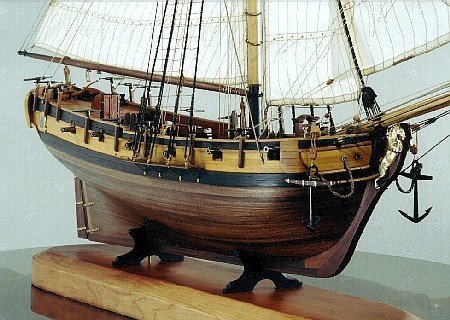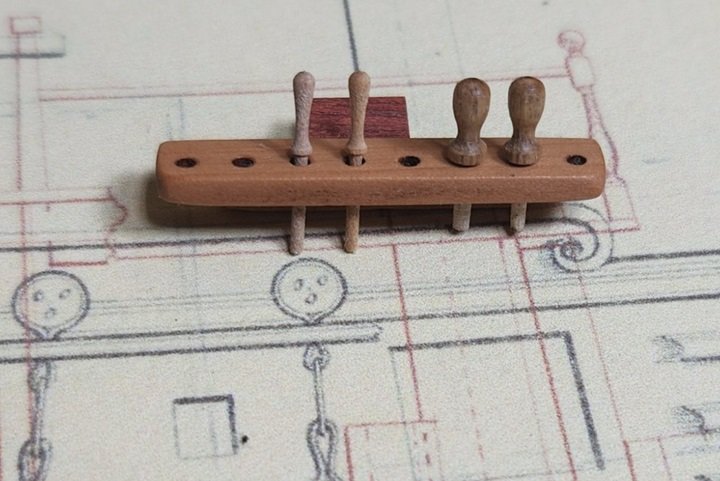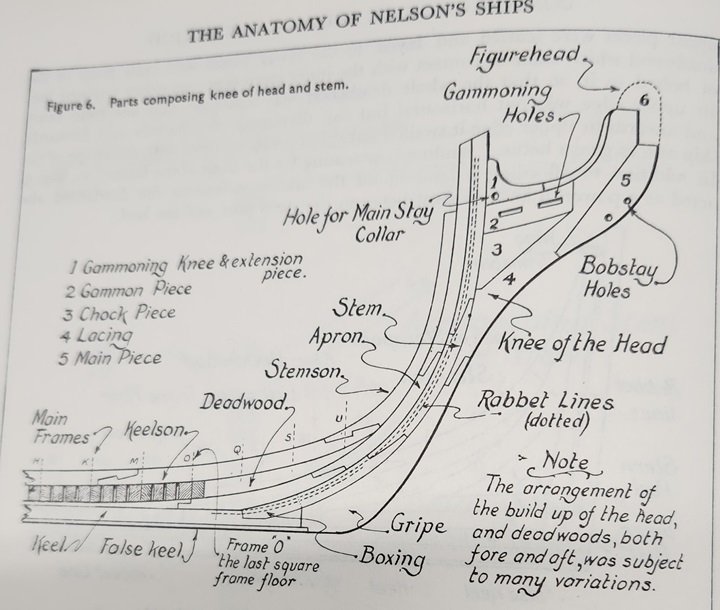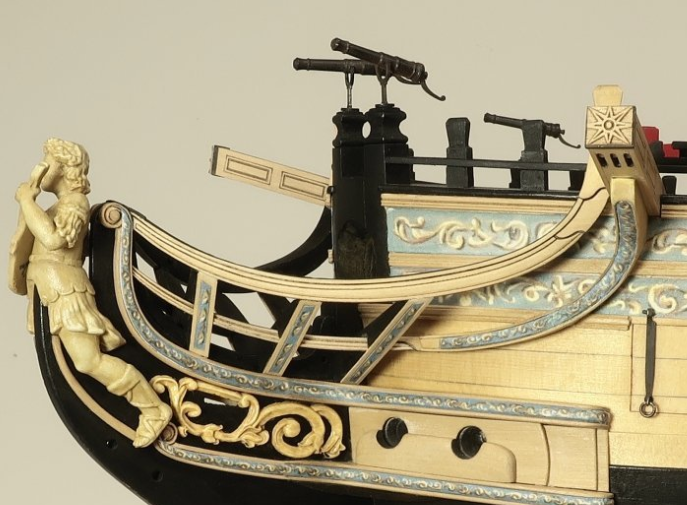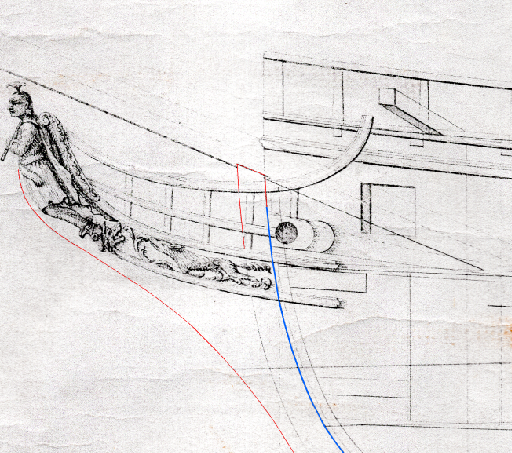-
Posts
3,135 -
Joined
-
Last visited
Content Type
Profiles
Forums
Gallery
Events
Everything posted by Gregory
-
Help with depicting extra line on bitts
Gregory replied to usedtosail's topic in Masting, rigging and sails
Then that makes it difficult for anyone to provide advice about how it should be done with regard to common/actual practice. It’s not just a matter of historical accuracy it’s also a matter how the rigging works efficiently for the control of the sails and the men handling the ropes. The basic principles haven’t changed for hundreds of years. -
Help with depicting extra line on bitts
Gregory replied to usedtosail's topic in Masting, rigging and sails
Determining how the falls were arranged at the bitts is a moot point if that is not where they should be. Referring to what TBlack said above regarding bowlines, clews and sheets , I’m pretty sure the bowlines ran forward to the bowsprit then back to the forecastle area. The sheets rove through sheaves In the bulwarks then to kevels or cleats on the bulwarks. I’ll have to re-visit the clews. -
Help with depicting extra line on bitts
Gregory replied to usedtosail's topic in Masting, rigging and sails
Thanks for replying. Well, Lees is a little complicated, or at least a little longwinded for me to quote everything here. I would like to see what others have to say before I get too deep into quoting Lees. My cursory reading doesn't show as may lines going to the bitts as I see here. I noticed in looking at the pictures of the prototype It doesn't appear there are as many lines leading down to the bitts as in the images up above. Your plan view appears to have fewer lines also. -
Help with depicting extra line on bitts
Gregory replied to usedtosail's topic in Masting, rigging and sails
Can you name some of these lines? No one has bothered to do this so far. With that information we might be able to find out more about how they should be rigged. -
Help with depicting extra line on bitts
Gregory replied to usedtosail's topic in Masting, rigging and sails
I'm still curious as to what some of those lines are. I can't imagine a lot of working lines wrapped around the bitts like that, regardless of where the extra rope would lay. -
Help with depicting extra line on bitts
Gregory replied to usedtosail's topic in Masting, rigging and sails
It would be interesting to know what some of those lines are and what something like Lees' has to say about them. -
Kit review USS Missouri (BB 63) - OcCre -1:200
Gregory replied to Kevin's topic in REVIEWS: Model kits
What are the notable differences? -
For modeling, I think it has a lot to do with the look you are going for, with nice proportions rather than precise measurements. A lot of modelers may not have the tools or desire to make their own, so it is good to be able find an acceptable source. Some of these are not like the others. The pins on the left are from Falkonet while the ones on the right are typical kit pins and what you find in a lot of retail outlets. The kit pins can be chucked up in a Dremel and made a lot better, but I have found that getting uniformity can be a challenge.
-
How will laser cutters compliment our hobby tomorrow?
Gregory replied to EspenT's topic in 3D-Printing and Laser-Cutting.
I really like the look of the new Syren blocks, but I have a lot of the old wood ones -
Vanguard Alert - Rigging problem
Gregory replied to rodricbraithwaiteRodric's topic in Masting, rigging and sails
I don't' think you can go wrong by looking at Chuck's Cheerful. Look through the log for more details. Also, all of the Cheerful rigging is available on the Syren Web site. Revenue Cutter Cheerful 1806 Another great log is from Thukydides He has posted an index to his build so it is easy to find the various steps. PS I just noticed Alert shrouds don't use the cross trees and trestle trees. So you should feel confident following Goodwin and Thukydides. -
How will laser cutters compliment our hobby tomorrow?
Gregory replied to EspenT's topic in 3D-Printing and Laser-Cutting.
While there are some real nice printed parts, I'm reluctant to go down that road for most parts in model sailing ship building. I like working with wood, and I don't like to paint, which is required for most printed parts. -
How will laser cutters compliment our hobby tomorrow?
Gregory replied to EspenT's topic in 3D-Printing and Laser-Cutting.
I hope you don't think I'm talking about piracy. I'm talking about making replacement parts for personal use from a kit or plans I own.. Typically to replace some parts with better wood like box or pear. The laser is also great for cutting out spiled planks. Being able to buy laser files from a kit maker would make it all that easier for a pirate to do their thing. -
How will laser cutters compliment our hobby tomorrow?
Gregory replied to EspenT's topic in 3D-Printing and Laser-Cutting.
I can see kit makers being reluctant to sell their files, however if you already have a kit, its pretty easy to scan a part or plan and make an image that LightBurn will convert to .SVG I do this already with kits and plans. -
A few questions about the new AL HMS Victory
Gregory replied to Daniel M's topic in Wood ship model kits
It's a little early for anyone to answer your questions. The kit was just released, and I haven't seen that anyone here has acquired one. -
Unknown Royal Yacht kit.
Gregory replied to Lucius Molchany's topic in - Kit build logs for subjects built from 1751 - 1800
Why is it banned? We don't ban kits just because they are of Chinese origin. Do we know it is a knock off of another kit? I didn't see another match. -
Unknown Royal Yacht kit.
Gregory replied to Lucius Molchany's topic in - Kit build logs for subjects built from 1751 - 1800
On 2nd look, has a lot more bulkheads than the Mamoli kit. Still looks like a similar design. I found this which looks like a good match. Free Shipping Scale 1/80 The Dutch Royal Yacht Wooden Model + Brass Upgrade Parts+ Alloy Anchor - Model Building Kits - AliExpress -
Unknown Royal Yacht kit.
Gregory replied to Lucius Molchany's topic in - Kit build logs for subjects built from 1751 - 1800
Looks like Mamoli kit Mary. Check the link in my signature..
About us
Modelshipworld - Advancing Ship Modeling through Research
SSL Secured
Your security is important for us so this Website is SSL-Secured
NRG Mailing Address
Nautical Research Guild
237 South Lincoln Street
Westmont IL, 60559-1917
Model Ship World ® and the MSW logo are Registered Trademarks, and belong to the Nautical Research Guild (United States Patent and Trademark Office: No. 6,929,264 & No. 6,929,274, registered Dec. 20, 2022)
Helpful Links
About the NRG
If you enjoy building ship models that are historically accurate as well as beautiful, then The Nautical Research Guild (NRG) is just right for you.
The Guild is a non-profit educational organization whose mission is to “Advance Ship Modeling Through Research”. We provide support to our members in their efforts to raise the quality of their model ships.
The Nautical Research Guild has published our world-renowned quarterly magazine, The Nautical Research Journal, since 1955. The pages of the Journal are full of articles by accomplished ship modelers who show you how they create those exquisite details on their models, and by maritime historians who show you the correct details to build. The Journal is available in both print and digital editions. Go to the NRG web site (www.thenrg.org) to download a complimentary digital copy of the Journal. The NRG also publishes plan sets, books and compilations of back issues of the Journal and the former Ships in Scale and Model Ship Builder magazines.

